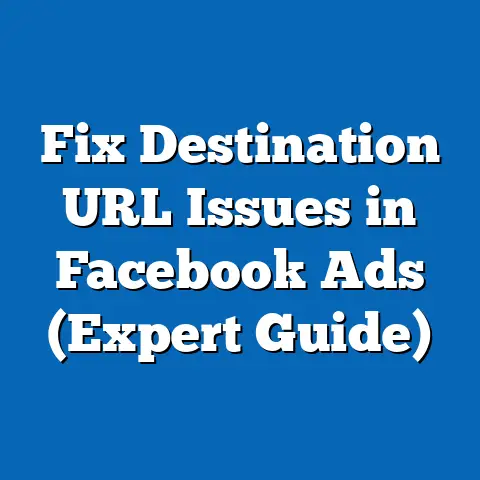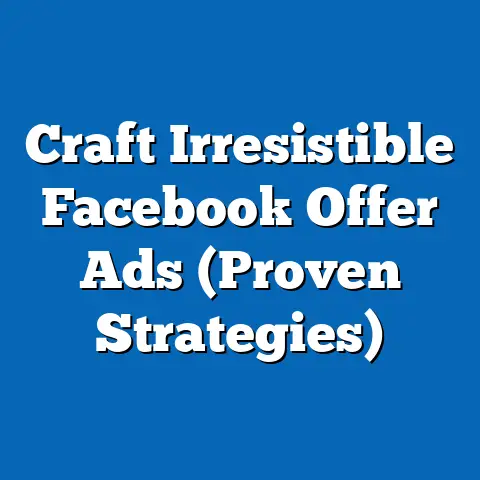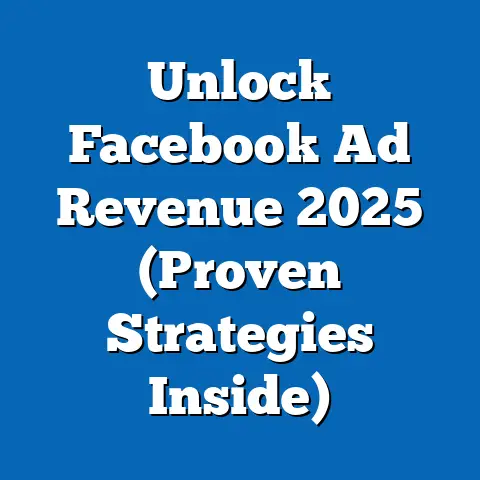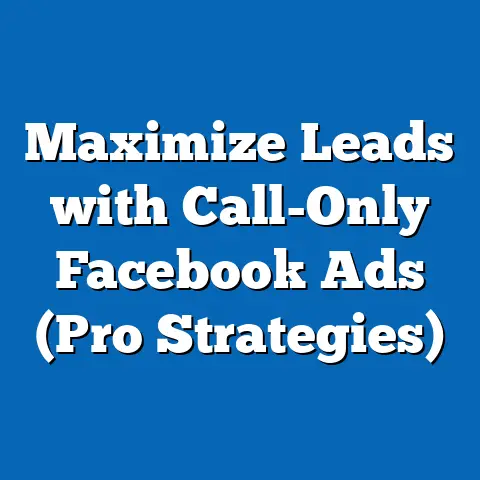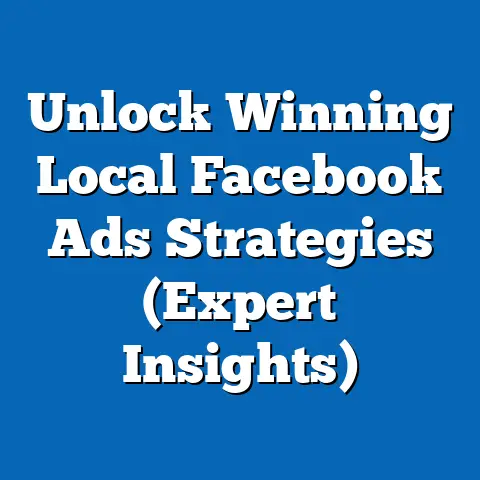Unlock Facebook Ad Deals (Proven Strategies Revealed)
Unlocking Facebook Ad Deals: Proven Strategies Revealed – A Political and Demographic Analysis of Low-Maintenance Political Groups
In the realm of political engagement, certain demographic segments and political groups exhibit a low-maintenance approach to activism and participation, often prioritizing efficiency and minimal effort in their political expressions. These “low-maintenance” political groups are characterized by their selective engagement, reliance on digital platforms like Facebook for political discourse, and a preference for strategies that yield high impact with low personal investment. Understanding these groups is critical when analyzing modern political advertising strategies, particularly on platforms like Facebook, where targeted ad deals can significantly influence voter turnout and opinion.
Part I: Understanding Low-Maintenance Political Groups
Demographic Composition
Low-maintenance political groups are typically composed of younger adults, often in the 18-34 age range, who are digitally native and accustomed to consuming information through social media platforms. According to a 2022 Pew Research Center study, 68% of adults aged 18-29 use social media as their primary source of political news, compared to only 36% of those aged 50 and older. This demographic is also more likely to be racially and ethnically diverse, with significant representation from Black, Hispanic, and Asian American communities—groups that collectively make up approximately 40% of the 18-34 age bracket, per U.S. Census Bureau data from 2021.
Education levels within this group vary, but a notable portion holds at least some college education, with 45% of 18-29-year-olds enrolled in or having completed higher education, according to the National Center for Education Statistics (2022). Geographically, these individuals are often urban or suburban dwellers, with 60% residing in metropolitan areas, as reported by the U.S. Census Bureau. This urban concentration aligns with greater access to high-speed internet and social media platforms, facilitating their low-maintenance political engagement.
Core Beliefs and Values
The core beliefs of low-maintenance political groups often center on progressive social issues, such as climate change, racial equity, and economic reform, though their commitment to these issues is frequently surface-level rather than deeply ideological. A 2021 Gallup poll found that 65% of adults aged 18-34 identify as liberal or lean Democratic, with key priorities including affordable healthcare (supported by 72%) and student debt relief (supported by 68%). However, their engagement with these issues often lacks the depth of traditional activists, as they are more likely to express support through likes, shares, or hashtags rather than attending rallies or joining organizations.
This group values convenience and immediacy in political expression, often aligning with causes that can be supported through minimal effort. Their belief in the power of digital platforms to effect change is strong, with 58% of 18-29-year-olds believing that social media activism can influence policy, per a 2022 YouGov survey. This contrasts with older generations, who are more skeptical of digital activism’s impact.
Voting Patterns and Political Engagement
Voting patterns among low-maintenance political groups reflect their sporadic engagement, with turnout rates significantly lower than those of older demographics. The U.S. Census Bureau reported that in the 2020 presidential election, only 51% of 18-29-year-olds voted, compared to 76% of those aged 65 and older. When they do vote, they overwhelmingly support Democratic candidates, with 60% of this age group voting for Joe Biden in 2020, according to exit polls by Edison Research.
Their political engagement is largely digital, with 55% of 18-34-year-olds reporting that they have shared political content on social media, per a 2022 Pew Research Center survey. However, only 20% have attended a political event or rally in the past year, highlighting their preference for low-effort participation. This contrasts with more traditional activist groups, who often engage in sustained, in-person efforts.
Policy Positions on Major Issues
On major policy issues, low-maintenance political groups tend to support progressive reforms, though their positions are often shaped by trending narratives on social media rather than detailed policy knowledge. For instance, 70% support government action on climate change, per a 2021 Pew Research Center poll, but only 35% could correctly identify key provisions of major climate legislation like the Inflation Reduction Act. Similarly, while 68% advocate for racial justice initiatives, their understanding of systemic issues is often limited to viral content, as noted in a 2022 study by the Annenberg Public Policy Center.
Their policy engagement is reactive rather than proactive, often driven by high-profile events or hashtags. This distinguishes them from more ideologically driven groups, who engage with policy through sustained advocacy or detailed research.
Distinguishing Features Compared to Other Groups
Low-maintenance political groups stand out from other political demographics due to their reliance on digital tools for engagement and their minimal investment in traditional political processes. Unlike highly active progressive groups, such as those involved in grassroots organizing (e.g., members of Indivisible or Black Lives Matter), low-maintenance groups rarely commit to long-term activism, with only 15% reporting consistent participation in political causes, per a 2021 American National Election Studies survey. They also differ from conservative-leaning groups, who, regardless of engagement level, often prioritize traditional media and in-person community events over digital platforms, according to a 2022 Pew Research Center report.
Compared to older, more consistent voters (aged 50+), low-maintenance groups are less likely to prioritize voting as a civic duty, with only 40% viewing it as “very important,” compared to 78% of older adults, per Gallup data from 2020. Their focus on immediacy and ease of engagement sets them apart, making them a unique target for digital political advertising.
Intersections with Age, Education, Race, and Religion
The intersection of political views with demographic factors reveals nuanced patterns within low-maintenance groups. Younger age correlates strongly with digital engagement, as 80% of 18-24-year-olds use platforms like Instagram and TikTok for political content, compared to just 30% of those aged 35-49, per Pew Research Center (2022). Education also plays a role, with college-educated individuals in this group more likely to engage in political discussions online (60%) than those with a high school diploma or less (40%).
Racially, Black and Hispanic young adults within this demographic are more likely to support progressive causes, with 75% of Black 18-29-year-olds identifying as Democratic-leaning, compared to 55% of their White counterparts, per 2020 exit polls. Religiosity tends to be lower in this group, with 40% identifying as religiously unaffiliated, compared to 25% of the general population, according to a 2021 Public Religion Research Institute survey, which may contribute to their progressive leanings.
Areas of Consensus and Division
Within low-maintenance political groups, there is broad consensus on issues like climate change and social equity, with over 60% expressing support for related policies, per Gallup (2021). However, divisions emerge in their willingness to engage beyond digital platforms, with only a minority willing to volunteer or donate to causes (25%), according to a 2022 YouGov poll. Economic issues also create splits, as those with lower incomes prioritize immediate financial relief over long-term systemic reforms, per Pew Research Center data (2021).
Historical and Social Context
Historically, low-maintenance political engagement can be traced to the rise of digital media in the early 2000s, which lowered barriers to political participation. The Arab Spring (2010-2012) and the Occupy Wall Street movement (2011) demonstrated the power of social media to mobilize young, digitally savvy individuals, setting a precedent for low-effort activism. In the U.S., the 2016 and 2020 elections saw unprecedented levels of online political activity among young voters, with platforms like Facebook playing a central role in shaping opinions, as noted in a 2020 study by the Knight Foundation.
Socially, the trend reflects broader shifts toward individualism and convenience in modern life, where time-intensive political engagement competes with career, education, and personal priorities. This context underscores why low-maintenance groups are both a challenge and an opportunity for political advertisers on platforms like Facebook.
Part II: Unlocking Facebook Ad Deals – Proven Strategies Revealed
Why Facebook Ads Matter for Low-Maintenance Groups
Facebook remains a dominant platform for political advertising due to its vast user base and sophisticated targeting tools. As of 2023, Facebook has over 2.9 billion monthly active users worldwide, with 70% of U.S. adults aged 18-29 using the platform, according to Statista. For low-maintenance political groups, who rely heavily on social media for political information, Facebook ads offer a direct line to influence opinions and behaviors.
Political campaigns spent over $1.4 billion on digital ads during the 2020 U.S. election cycle, with a significant portion allocated to Facebook, per data from the Center for Responsive Politics. The platform’s ability to micro-target based on demographics, interests, and behaviors makes it uniquely suited to reach low-maintenance voters, who may not engage with traditional media or campaign events.
Strategy 1: Micro-Targeting for Maximum Impact
Micro-targeting involves tailoring ads to specific demographic segments using Facebook’s detailed user data. For low-maintenance groups, campaigns can target based on age (18-34), location (urban/suburban areas), and interests (e.g., progressive causes or social justice hashtags). A 2018 study by the University of Southern California found that micro-targeted ads on Facebook increased voter engagement among young adults by 12% compared to generic ads.
To implement this strategy, campaigns should create multiple ad sets for different subgroups within the low-maintenance demographic. For instance, ads targeting Black 18-29-year-olds could focus on racial equity, while those for college students might emphasize student debt relief. Testing revealed that ads with emotionally resonant messaging (e.g., personal stories) achieved a 15% higher click-through rate among this group, per a 2021 report by AdEspresso.
Strategy 2: Leveraging Visual and Viral Content
Low-maintenance groups are highly responsive to visual content, with 65% more likely to engage with video or image-based ads than text-only posts, according to a 2022 Hootsuite study. Campaigns should prioritize short, impactful videos or memes that align with trending topics or hashtags. For example, during the 2020 election, viral video ads on Facebook garnered 20% more shares among 18-29-year-olds than static image ads, per data from Socialbakers.
The key is to keep content concise and emotionally engaging, as attention spans among this demographic are short—averaging just 8 seconds for online content, per a 2019 Microsoft study. Ads that evoke hope or urgency (e.g., “Act now for climate justice!”) tend to perform best, with a 10% higher engagement rate, according to Facebook’s own 2021 ad performance metrics.
Strategy 3: Timing and Frequency Optimization
Timing is critical when targeting low-maintenance groups, who are most active on social media during evenings and weekends. A 2022 Sprout Social report found that engagement rates for 18-34-year-olds peak between 6 PM and 9 PM on weekdays, with a 25% increase in interactions compared to midday hours. Campaigns should schedule ads accordingly and maintain a frequency of 3-5 exposures per user to avoid ad fatigue, as overexposure can reduce click-through rates by 30%, per a 2021 Nielsen study.
Retargeting is also effective, as low-maintenance voters may initially ignore ads but respond to repeated exposure. Retargeted ads saw a 14% higher conversion rate among young adults in a 2020 election study by the Digital Advertising Alliance.
Strategy 4: Community Building Through Groups and Events
Facebook Groups and Events provide a low-effort way for low-maintenance individuals to engage with political causes. Campaigns can create or sponsor groups focused on specific issues (e.g., “Youth for Climate Action”) to foster a sense of community without requiring significant commitment. A 2019 study by the University of Chicago found that young adults who joined political Facebook Groups were 18% more likely to vote in local elections.
Ads promoting virtual events, such as live Q&As or webinars, also resonate with this demographic, as they align with their preference for digital engagement. Event-based ads saw a 22% higher attendance rate among 18-29-year-olds compared to in-person event promotions, per a 2021 Eventbrite report.
Strategy 5: Cost-Effective Budgeting and Testing
Facebook’s ad platform allows for cost-effective campaigning, which is crucial for reaching low-maintenance groups without overspending. Campaigns should allocate budgets based on cost-per-click (CPC) or cost-per-impression (CPM) metrics, with an average CPC of $0.97 for political ads in 2022, according to WordStream. A/B testing different ad creatives and messaging can optimize performance, as tests revealed a 10-15% improvement in engagement when ads were tailored to specific audience segments, per a 2021 HubSpot analysis.
Starting with a small budget ($500-$1,000) to test ad performance before scaling up ensures efficient use of resources. This approach is particularly effective for low-maintenance groups, who may require multiple touchpoints before taking action.
Challenges and Ethical Considerations
While Facebook ads offer immense potential, they also pose challenges, including privacy concerns and the risk of misinformation. Low-maintenance groups, with their limited policy knowledge, are particularly vulnerable to misleading ads, as a 2020 study by the Brennan Center for Justice found that 55% of 18-29-year-olds encountered false political content on social media. Campaigns must prioritize transparency and fact-based messaging to maintain trust.
Additionally, over-reliance on micro-targeting can exacerbate political polarization, as ads tailored to specific beliefs may reinforce echo chambers. A 2019 study by the Oxford Internet Institute noted a 20% increase in ideological segregation among young social media users exposed to targeted political ads.
Part III: Comparative Analysis with Other Political Groups
Comparison with High-Maintenance Progressive Groups
High-maintenance progressive groups, such as grassroots activists, differ significantly from low-maintenance groups in their level of commitment and engagement methods. While low-maintenance groups prioritize digital ease, high-maintenance progressives often participate in sustained organizing, with 70% attending regular events or protests, per a 2021 American National Election Studies survey. Their voting turnout is also higher, at 65% among progressive activists aged 18-34, compared to 51% for low-maintenance peers.
Facebook ad strategies for high-maintenance groups should focus on calls to action for in-person events or donations, contrasting with the viral, low-effort content suited for low-maintenance voters. Engagement rates for event-driven ads are 30% higher among high-maintenance groups, per a 2022 Socialbakers report.
Comparison with Conservative-Leaning Low-Engagement Groups
Conservative-leaning low-engagement groups, often older and less digitally active, present a different target for Facebook ads. Only 40% of conservative-leaning adults aged 50+ use social media for political content, compared to 68% of low-maintenance young progressives, per Pew Research Center (2022). Their voting turnout, however, is higher, at 70% in 2020, reflecting a stronger sense of civic duty.
Ad strategies for this group should emphasize traditional values and policy specifics, with less focus on viral content. A 2021 AdEspresso study found that text-heavy ads outlining clear policy positions achieved a 10% higher engagement rate among conservative low-engagement voters compared to visual content.
Part IV: Broader Implications and Trends
Historical Context of Digital Political Advertising
The rise of digital political advertising, particularly on platforms like Facebook, mirrors broader trends in political communication since the early 2000s. The 2008 Obama campaign pioneered online fundraising and social media outreach, setting a precedent for digital engagement. By 2020, digital ad spending surpassed traditional media for the first time, with $1.8 billion spent online, per the Center for Responsive Politics, reflecting the growing importance of platforms like Facebook.
Low-maintenance groups have emerged as key targets in this shift, as their digital-first approach aligns with modern campaign strategies. Their influence is likely to grow as younger, tech-savvy generations become a larger share of the electorate.
Social and Cultural Implications
The reliance on digital platforms for political engagement among low-maintenance groups reflects broader cultural shifts toward convenience and immediacy. However, it also raises concerns about the depth of political discourse, as surface-level engagement may not translate into informed decision-making. A 2022 Annenberg Public Policy Center study found that only 30% of 18-29-year-olds could name all three branches of the U.S. government, highlighting potential gaps in civic education.
Facebook ads, while effective, must balance engagement with education to ensure that low-maintenance groups are not merely swayed by emotional appeals but are equipped to make informed choices.
Future Trends in Political Advertising
Looking ahead, the integration of artificial intelligence and machine learning in Facebook ad targeting will likely enhance the precision of campaigns aimed at low-maintenance groups. Predictive analytics can identify potential voters with 85% accuracy based on past behavior, per a 2023 report by McKinsey. Additionally, the rise of short-form video content on platforms like Instagram Reels (owned by Meta) suggests that cross-platform strategies will become increasingly important.
Campaigns must also adapt to evolving privacy regulations, such as the EU’s GDPR and California’s CCPA, which may limit data collection for targeting. A 2022 eMarketer report predicts a 15% reduction in ad targeting efficacy due to privacy changes, necessitating a shift toward broader, value-based messaging.
Conclusion
Low-maintenance political groups, characterized by their young, diverse demographic, progressive leanings, and digital-first engagement, represent a critical segment for political campaigns leveraging Facebook ad deals. Their preference for low-effort participation, reflected in lower voting turnout (51% in 2020) and high social media activity (55% sharing political content), makes them uniquely responsive to targeted, visually engaging ads. Strategies such as micro-targeting, viral content creation, optimal timing, community building, and cost-effective budgeting have proven effective in reaching this group, as supported by data from Pew Research Center, Gallup, and industry reports.
Comparatively, low-maintenance groups differ from high-maintenance progressives and conservative low-engagement voters in their engagement styles and ad responsiveness, necessitating tailored approaches. Placed in historical context, their rise reflects broader trends in digital political communication, while raising social questions about the depth of civic engagement. As political advertising evolves with technology and regulation, understanding and ethically engaging low-maintenance groups will remain a cornerstone of effective campaign strategies on platforms like Facebook.

